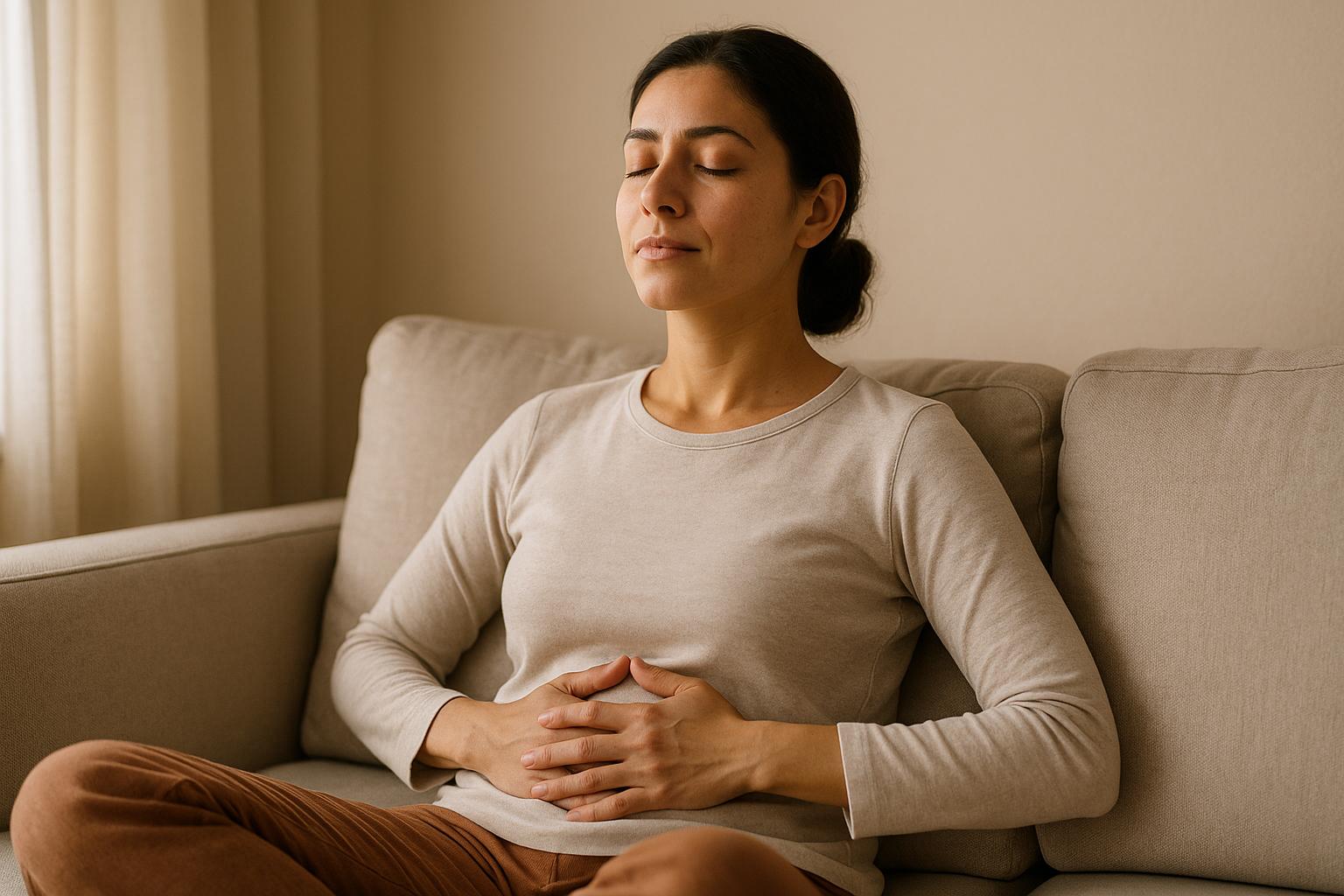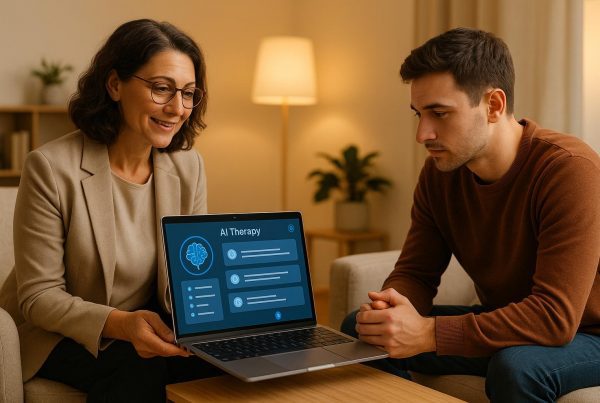Progressive Muscle Relaxation (PMR) is a simple technique that helps reduce stress by systematically tensing and relaxing muscle groups. It’s backed by research showing it can lower anxiety, improve sleep, and ease physical tension. PMR works by calming the body’s "fight-or-flight" response and activating its relaxation system. The best part? It requires no special tools, can be done anywhere, and suits all ages.
Key Benefits:
- Mental Health: Reduces anxiety, improves focus, and enhances emotional control.
- Physical Health: Lowers heart rate, reduces blood pressure, and improves sleep quality.
- Accessibility: Easy to practice at home or on the go.
PMR is even more effective with digital tools like Aidx.ai, which offers guided sessions and personalized stress management features. Whether you’re managing daily stress or preparing for a big event, PMR is a practical way to relax and recover.
Benefits of Progressive Muscle Relaxation for Stress Recovery
Mental Health Benefits
Progressive Muscle Relaxation (PMR) has a powerful impact on mental health, particularly in reducing anxiety and improving emotional regulation. Studies consistently show that practicing PMR leads to measurable decreases in anxiety. For example, in a study involving 50 hospitalized cancer patients, those who practiced PMR experienced significant reductions in anxiety, as assessed by the Generalized Anxiety Questionnaire. Meanwhile, the control group showed no such improvements[1]. Another study found that coronary heart disease patients who practiced PMR twice daily for five days reported notable drops in both depression and anxiety levels, measured using the Hospital Anxiety and Depression Scale[1].
PMR also helps with emotional regulation by teaching you to notice and release physical tension tied to stress and negative emotions[5]. This heightened body awareness allows you to catch early signs of stress or anxiety, equipping you with better coping strategies. Many people report that PMR helps them stay present and focused, quieting the mental noise that often accompanies stress.
Additionally, PMR enhances mental clarity by redirecting your focus to physical sensations in the moment[4][5]. By systematically tensing and relaxing each muscle group, you naturally pull your attention away from racing thoughts, creating mental space for clearer thinking. This mindfulness aspect strengthens your ability to stay grounded and sharp, even in stressful situations.
These mental benefits set the stage for meaningful physical changes as well.
Physical Health Benefits
The physical perks of PMR go beyond just relaxing your muscles. One of its primary effects is shifting your nervous system from "fight-or-flight" mode to "rest and digest" mode, leading to lower heart rate, reduced blood pressure, and decreased cortisol levels[4][2].
Improved sleep is another well-documented benefit. A 2020 study involving 80 burn patients found that practicing PMR for 20–30 minutes daily over three days significantly enhanced sleep quality[3]. The same study also noted reduced anxiety levels, highlighting the connection between physical relaxation and mental well-being.
PMR is also effective in easing stress-related headaches. By helping you become more aware of muscle tension, the technique enables you to release it before it escalates into pain, providing a proactive way to manage physical discomfort tied to stress.
PMR vs Other Relaxation Techniques
While several relaxation techniques can aid stress recovery, PMR offers a unique combination of physical engagement and mindfulness. Comparative studies highlight how PMR differs from other methods. For instance, a study involving 60 healthy undergraduate participants found that PMR, deep breathing, and guided imagery all significantly improved psychological relaxation compared to control groups[1].
| Technique | Mechanism | Benefits | Supporting Evidence |
|---|---|---|---|
| PMR | Sequentially tensing and relaxing muscles | Reduces anxiety, relaxes muscles, improves sleep | Multiple RCTs, physiological studies[1][3] |
| Deep Breathing | Slow, controlled breathing patterns | Lowers stress, reduces heart rate, simple to learn | Clinical trials, physiological data[1] |
| Guided Imagery | Visualizing calming scenes | Eases anxiety, improves mood, promotes relaxation | RCTs, psychological assessments[1] |
The research highlights some intriguing differences. While PMR and guided imagery both produce immediate and consistent relaxation, deep breathing may initially raise physiological arousal before returning to baseline levels[1]. This makes PMR especially effective for those seeking immediate, steady physical relaxation.
What sets PMR apart is its dual focus on active muscle engagement and mindfulness. Unlike deep breathing, which centers solely on respiratory control, or guided imagery, which depends on visualization skills, PMR works through direct, physical action that anyone can practice and feel right away. This unique combination of benefits makes PMR an essential tool for comprehensive stress recovery.
Step-by-Step Guide to Practicing Progressive Muscle Relaxation
Getting Ready for PMR
To get the most out of Progressive Muscle Relaxation (PMR), setting up the right environment is essential. Find a quiet spot where interruptions are unlikely. Silence your phone or turn it off entirely to avoid distractions.
Wear loose, comfortable clothing, and make sure the room temperature feels just right – not too hot or cold. Choose a position that feels comfortable for you: either sit in a supportive chair with your feet flat on the floor or lie down on your back on a bed or yoga mat. If you’re sitting, keep your back straight but relaxed. If lying down, let your arms rest naturally at your sides with your palms facing up.
Plan for about 20-30 minutes for your session. PMR doesn’t require special tools – just your attention, focus, and a peaceful space. Dim lighting can help create a calming atmosphere. Once you’re settled, you’re ready to begin.
The PMR Sequence
PMR works by systematically relaxing different muscle groups across your body. Start at your toes and gradually work your way up. This structured approach ensures no area is overlooked.
Follow this sequence: toes and feet, calves, thighs, buttocks and hips, abdomen, chest, hands and forearms, biceps and shoulders, neck, jaw, and finally, your forehead and scalp. Moving in this order helps maintain focus and creates a natural rhythm for your session.
This step-by-step routine not only helps you stay present but also builds a cumulative sense of relaxation as you progress. By sticking to the same sequence each time, your body becomes familiar with the pattern, making it easier to relax with practice. Once you’ve mastered the sequence, it’s time to focus on the tension-and-relaxation technique.
Tensing and Relaxing Technique
The heart of PMR lies in alternating between muscle tension and relaxation. For each muscle group, tighten the muscles firmly for about 5 seconds, then release and relax for 10-20 seconds. The timing is key – 5 seconds is enough to feel the tension without discomfort, while the longer relaxation period allows your body to fully register the shift.
Here’s how to apply tension correctly: for your feet, curl your toes downward; for your thighs, tighten the muscles; for your arms, make a fist and bend your elbows. The goal is to create noticeable tension, but stop short of causing pain.
Breathing plays a big role in enhancing PMR. Breathe deeply and slowly throughout the session. A good rhythm is to inhale while tensing the muscles, hold the breath for 5 seconds, and exhale as you relax. This breathing pattern activates your parasympathetic nervous system, which helps your body enter a calm, restful state.
Pay close attention to the sensations in your body as you move from tension to relaxation. If your mind starts to wander – whether to daily worries or tomorrow’s to-do list – gently bring your focus back to how your body feels. This act of refocusing is a mindfulness practice in itself.
Avoid common mistakes like tensing muscles too hard, which can cause trembling or discomfort. Don’t hold your breath for the entire process; instead, sync your breathing with the tension-relaxation cycle. Take your time – don’t rush through the steps or skip muscle groups, even if they don’t feel tense.
During the relaxation phase, notice how each muscle group feels as it releases tension. Some people find it helpful to use mental cues, such as silently saying “tension” when tightening and “relax” or “release” when letting go. This simple practice strengthens the mind-body connection, turning PMR into a powerful tool for both physical and emotional well-being.
Consistency is more important than perfection. It’s completely normal if you don’t feel deeply relaxed after your first session. The goal is to become more aware of the contrast between tension and relaxation in your body. Over time, this awareness can help you manage stress and release tension more effectively in everyday life.
PMR (Progressive Muscle Relaxation) to Help Release Tension, Relieve Anxiety or Insomnia
sbb-itb-d5e73b4
Digital Tools for PMR Practice
Digital tools have brought new possibilities to Progressive Muscle Relaxation (PMR), offering guided sessions, tailored routines, and progress tracking to help manage stress more effectively. Studies indicate that just 20 minutes of PMR, delivered through recorded audio, can significantly enhance relaxation and reduce stress levels when compared to control groups[1].
Today’s PMR platforms have advanced features like voice-enabled interfaces, personalized routines, and real-time feedback. These tools combine step-by-step audio guidance with customization options and reminders, making it easier to develop and maintain relaxation habits. The result? A more flexible and individualized PMR experience that fits seamlessly into modern lifestyles[4][3].
How Aidx.ai Supports PMR

Aidx.ai takes PMR to the next level by offering professional-grade guidance through a hands-free, voice-enabled interface. This platform walks you through each muscle group with evidence-based relaxation techniques, creating a personal coach-like experience. Beyond PMR, Aidx.ai integrates therapeutic methods such as Cognitive Behavioral Therapy (CBT), Dialectical Behavior Therapy (DBT), Acceptance and Commitment Therapy (ACT), and Neuro-Linguistic Programming (NLP). This combination addresses both the physical tension and the mental patterns that contribute to stress.
What sets Aidx.ai apart is its ATI System™, which learns your communication style and stress triggers. This system adjusts session length, intensity, and focus areas based on your progress and needs. Instead of delivering a one-size-fits-all routine, it tailors each session to your unique stress patterns, making the practice more effective and engaging.
Key Features for Stress Recovery
Aidx.ai transforms PMR into a data-driven approach to stress management with its self-monitoring tools. After each session, you can log your stress levels, emotions, and physical sensations, allowing you to track how PMR impacts your well-being and uncover patterns in your stress response.
The platform also helps turn PMR into a consistent habit. Its planning system lets you set personalized goals – like completing a set number of sessions per week or gradually lowering your stress levels. Notifications and email reminders keep you on track, and with 24/7 accessibility, stress relief is always within reach. Whether you need to calm your nerves before a big presentation or unwind after a long day, Aidx.ai is there to support you across multiple devices.
For added flexibility, Aidx.ai offers specialized modes tailored to different needs. Life Mode focuses on personal stress and emotional well-being, Business Mode helps with workplace tension and performance anxiety, and Performance Mode is designed for athletes and high performers who need precise stress management.
Privacy is a top priority for Aidx.ai. The platform uses full encryption, complies with GDPR standards, and even includes an optional incognito mode to ensure your sessions and data remain confidential.
| Feature | Benefit for PMR Practice | Impact on Stress Recovery |
|---|---|---|
| Voice-Enabled Interface | Hands-free guidance during sessions | Maintains relaxation without interruptions |
| ATI System™ Personalization | Adapts to individual stress patterns | Maximizes effectiveness with tailored routines |
| Self-Monitoring Tools | Tracks stress levels and progress | Provides data-driven insights for improvement |
| 24/7 Accessibility | On-demand support anytime | Delivers immediate relief when needed |
| Goal-Setting Integration | Creates structured practice habits | Builds consistency for long-term benefits |
Imagine activating a voice-guided PMR session during your lunch break. Aidx.ai could focus on relieving jaw and shoulder tension while prompting you to log your stress levels. This personalized approach not only tracks your progress but also sends reminders for future sessions, turning PMR into an evolving and dynamic tool for stress recovery.
Scientific Evidence and Clinical Uses of PMR
Research Evidence for PMR
Progressive Muscle Relaxation (PMR) has a strong foundation of scientific research backing its effectiveness in improving both mental and physical health. Studies involving diverse groups – such as nursing students, cancer patients, and individuals with heart disease – have shown that PMR can significantly lower anxiety, stress, and depression while improving sleep quality and overall well-being.
PMR is also a valuable tool for managing pain. For instance, a 2020 study involving 80 burn patients found that practicing PMR for 20–30 minutes daily over three days led to noticeable reductions in anxiety and better sleep quality[3].
The technique works by shifting the body from a "fight-or-flight" state, controlled by the sympathetic nervous system, to a calmer "rest-and-digest" mode governed by the parasympathetic system. This shift is marked by physiological changes such as a slower heart rate, reduced blood pressure, lower cortisol levels, and less muscle tension[2][4]. Additionally, meta-analyses and systematic reviews consistently highlight PMR’s ability to ease anxiety, reduce stress, and improve sleep, solidifying its place as a reliable method for enhancing overall well-being[1][3]. These findings have made PMR a trusted approach in various clinical settings.
PMR in Clinical Practice
Given its proven benefits, PMR is widely used in hospitals, mental health clinics, and rehabilitation centers to help manage conditions such as anxiety, depression, chronic pain, cardiovascular issues, cancer, and sleep problems[1][2]. Healthcare providers often introduce PMR through guided sessions, which may be conducted in person or via audio recordings. These sessions teach patients to systematically tense and relax different muscle groups, typically starting from the feet and moving upward or from the head downward[2][4].
PMR is flexible enough to be used in both individual and group settings, from oncology and cardiac rehabilitation programs to pain management clinics. Its simplicity – requiring no special equipment – makes it easy for patients to practice at home, in hospital beds, or even in waiting areas. This accessibility makes PMR a practical, non-drug option that avoids side effects or interactions with medications.
Moreover, PMR is increasingly seen as a cost-effective way to improve patient outcomes while reducing dependence on medications[1][2]. Digital platforms like Aidx.ai are expanding PMR’s reach by offering guided sessions and tools to track progress between clinical visits, further integrating this technique into modern healthcare practices.
Conclusion
Progressive Muscle Relaxation (PMR) offers a practical and effective way to manage stress and improve mental health. Research highlights its ability to ease stress, anxiety, and depression while enhancing sleep quality and overall physical well-being[1][3]. One of its standout features is its simplicity – no special tools are needed, and it can be practiced almost anywhere.
The method involves systematically tensing and relaxing different muscle groups, which helps lower heart rate, reduce blood pressure, and decrease cortisol levels[4][2]. This shift from the body’s "fight-or-flight" response to a calmer "rest-and-digest" state contributes to lasting improvements in both mental and physical health.
In today’s digital age, PMR has been elevated by tools like Aidx.ai. This platform enhances the experience with voice-guided sessions, personalized support through its ATI System™, and integrated progress tracking. Its conversational approach ensures users can access PMR guidance whenever and wherever they need it.
The combination of PMR with cutting-edge digital tools reflects a growing focus on accessible and tailored wellness solutions. This blend empowers individuals to actively manage their stress while benefiting from customized, professional-grade support that aligns with their unique needs.
PMR remains a proven method for reducing stress, anxiety, and depression. When paired with Aidx.ai’s personalized features, it becomes an even more powerful tool for fostering resilience and promoting lasting mental well-being. Regular practice not only amplifies its stress-relief benefits but also helps establish a strong foundation for ongoing mental wellness.
FAQs
How effective is Progressive Muscle Relaxation for relieving stress compared to other techniques?
Progressive Muscle Relaxation (PMR) is a practical approach to stress relief, especially for those who find physical activity helps them unwind. The process involves systematically tensing and then relaxing different muscle groups, which helps release physical tension and fosters a sense of tranquility.
Unlike techniques such as mindfulness or deep breathing that primarily target mental or emotional relaxation, PMR bridges the gap by addressing both the physical and mental aspects of stress. This makes it particularly helpful for individuals who feel stress manifest as muscle tightness or physical discomfort. While its effectiveness can vary depending on personal preferences, many people consider PMR an excellent way to manage stress and enhance their overall well-being.
Can progressive muscle relaxation help with conditions like anxiety or chronic pain?
Progressive muscle relaxation (PMR) is an effective technique for managing anxiety and chronic pain. By intentionally tensing and then relaxing different muscle groups, it helps release physical tension tied to stress and discomfort, while encouraging a sense of calm.
For those dealing with anxiety, PMR can ease restlessness and provide a grounding effect by focusing attention on the body. For individuals with chronic pain, this method may help loosen tight muscles and improve comfort levels. However, it’s always a good idea to consult a healthcare professional to determine if PMR is the right approach for your situation.
How can digital tools like Aidx.ai improve the practice of Progressive Muscle Relaxation and make it more effective?
Digital tools like Aidx.ai bring a modern twist to Progressive Muscle Relaxation by offering a voice-enabled, hands-free experience that seamlessly integrates relaxation techniques into your daily life. With its Adaptive Therapeutic Intelligence (ATI) System, the platform tailors guidance to your specific needs, making the process more personalized and effective.
Beyond relaxation, Aidx.ai incorporates evidence-backed techniques such as CBT, DBT, ACT, and NLP to support mental well-being. Additional features like progress tracking, planning tools, and reminders help you stay consistent and monitor your journey, turning stress recovery into a more organized and achievable goal.



